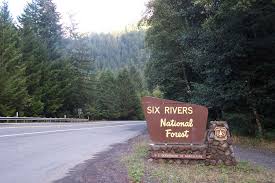Forest Service Baer Team Begins Post-Fire Assessment Of Monument & Knob Fires
Press release from Six Rivers National Forest:
Emergency actions may be necessary to provide for public safety and the protection of critical natural and cultural resources after large wildfires. For example, loss of vegetation exposes soil to erosion, water runoff may cause increased flooding, and sediment may move downstream damaging roads and infrastructure or put endangered species and cultural resources at-risk. USDA Forest Service Burned Area Emergency Response (BAER) teams implement rapid evaluations of burned areas on National Forest Service (NFS) lands, assess post-fire risks, and recommend emergency actions to the effected National Forests.
BAER teams focus specifically on emergency stabilization actions that are necessary to protect human life, property, and critical natural and cultural resources. BAER teams share their assessments with other federal, tribal, state, and local agencies that have post-fire responsibilities, including on state and private lands, within and downstream from burned areas. Such agencies include the USDA Natural Resources Conservation Service (NRCS), Natural Park Service (NPS), National Weather Service (NWS), Bureau of Land Management (BLM), Bureau of Indian Affairs (BIA), and US Geological Survey (USGS).
The Shasta-Trinity National Forest and Six Rivers National Forest have established a BAER team that is now beginning burned area assessments of the Monument and Knob fires. The BAER specialists on the Monument-Knob BAER assessment team include hydrologists, geologists, soil scientists, road and civil engineers, botanists, biologists, archeologists, recreation specialists, and geographic information specialists.
The Monument-Knob BAER assessment specialists are collecting data in the burned areas that is used to complete GIS and modeling programs to evaluate the post-fire risks. The first step in the BAER assessment process is taking satellite imagery and data collected during ground and aerial reconnaissance surveys to produce a soil burn severity map. The soil burn severity provides baseline information to determine changed watershed conditions for assessing potential watershed impacts from wildfires. This information will then be compiled and presented to Forest leadership along with recommended BAER emergency stabilization treatments in two BAER assessment reports—one for the Monument burned area, and one for the Knob burned area.
Rainstorm run-off is sometimes, but not always, increased on burn scars. The Monument and Knob BAER assessment reports and data will be shared with interagency cooperators who work with downstream private homeowners and landowners to prepare for potential post-fire flooding and debris flow impacts. Homes or businesses that could be impacted by flooding from federal land that resulted from wildfires may be eligible for flood insurance coverage from the National Flood Insurance Program (NFIP). Information about NFIP is available through FEMA at www.fema.gov/national-flood-
insurance-program, or www.floodsmart.gov/wildfires. Other flood preparedness information is available at www.ready.gov/floods at www.floodsmart.gov/.
SPECIAL NOTE: Everyone near and downstream from the burned areas should remain alert and stay updated on weather conditions that may result in heavy rains over the burn scars. Flash flooding may occur quickly during heavy rain events–be prepared to take action. Current weather and emergency notifications can be found at the National Weather Service websites: https://www.weather.gov/eka/ and https://www.weather.gov/sto/.


Join the discussion! For rules visit: https://kymkemp.com/commenting-rules
Comments system how-to: https://wpdiscuz.com/community/postid/10599/
Excellent!